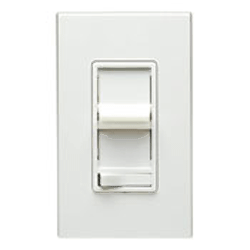it does not seem correct and I think it maybe a problem but need some advice. Had a ceiling fan today with a built in 3 speed reversable fan with switches on the fan. The power supply from the wall switch was on a reostat dimmer. Is this a problem ?
Did the fan spin and the lights come on?
yup they all worked, the fan seemed strained on low speed and lower dimmer setting, light on seperate on/off switch
Personally, if it worked, I’d be OK with it.
Motors will have a harder time starting on the lower speeds. Kind of like your car starting out in 3rd instead of 1st.
Are you sure it was a motor rated fan speed control or was it a lighting dimmer improperly used?
There are different “dimmers” (rheostats) for lights and fans. You will find that the ones for lights are used in place of the correct ones for fans. They are not created equal and should not be interchanged. Next time you go into one of the big box stores go over to the electrical section or the lighting / fan section and you can see for yourself. The ones for lights are usually cheaper than those for fans and I figure that is why we occasionally find one being used for fans. I write them up as needing replacement with the proper switch controls.
How do you know what’s “proper” if you can’t read the manufacturer’s literature (the dimmer is already installed)? How do you know this any installed dimmer is “improper”?
It is stamped onto the metal part of the dimmer / rheostat mount. Or I should say it has been on everyone I have looked at. Sound like you are being defensive, no need to be, we are all here to learn from each other.
What is stamped on the metal part of the dimmer??? So, you take the facepates off to read the dimmer stamps?
Not meaning to sound defensive. Sorry about that. Just trying to understand how you call out a dimmer without information to substantiate the defect you allege.
This is all I know about dimmers: “IRC 2006 E3901.12 Dimmer switches. General-use dimmer switches shall be used only to control permanently installed incandescent luminaires (lighting fixtures) except where listed for the control of other loads and installed accordingly.”
I just don’t know how you determine whether or not they are listed for their use without being technically exhaustive in the inspection. I’m actually hoping to learn something here, while playing devil’s advocate.
Ron, I have seen where the fan will hum because the dimmer is not giving it enough power to operate correctly. They have 3 speeds that is controlled by a chain or a remote controll for a reason. There is still full power being supplied to the fan or the controller. I always tell my clients if the fan starts to hum then turn the dimmer all the way up and controll the speed by the chain.
At least in my experiences fan speed controls start out on high and reduce to low to allow the motor to start to spin.
Lighting dimmers start on low and go to high.
Don’t know if it can be read as it is pretty small writing. But what it reads is:
“For permanently installed incandescent fixtures ONLY”
and it does not constitute a technically exhaustive inspection, takes only a few seconds if you carry an electric screwdriver like I do. You can usually tell if the rheostat is cheap, flimsy or worn out. The good ones have a solid tactile feel to the operation.
Now that having been said, I think I am done giving any advise on this board or any other.

Don’t get mad, Doug. It was good advice and I learned something! Thanks.
I used to work for Lutron Dimmers. Fan controls have high, med, and low clicks. If it is truly variable than it is for incandescent lighting only.
That true however I know one or two total variable fan speed control still on the market that can be misindentifed as conventail dimmer.
The total varibale fan speed control useally don’t have dehummer feature in there it will be noticeable on lowspeed operation.
Merci,Marc
thanks all for the good info
I have seen “continuously variable” speed controls for inductive loads such as ceiling fans. When the control is switched on, the fan starts at the highest (fastest) setting, then slows to a minimum speed setting as the control is adjusted. The controller also has a “trim pot” for setting the minimum speed, to prevent stalling.
Mike
Some of the newer units are really hard to ID visually, like this one…
**Leviton SureSlide Full-Range Fan Speed Controls
**(Model # 6637-P)
NOTE: DOES NOT INCLUDE FACE PLATE!
http://www.twacomm.com/assets/images/popicon.gif Detail Box](http://www.twacomm.com/catalog/model_6637-P.htm?sid=6EB2572898DB80FD70DEB6237DCCA58A) http://www.twacomm.com/assets/images/PDF.gif Product Brochure](http://assets.twacomm.com/assets/pdf/17818.pdf) (pdf)
Note: Picture may not represent the actual product. We are continuously working on improving our website and reserve the right to change specifications and availability without prior notice.
Sureslide 3-way fan speed control with preset on/off. Features:
- 5 Amps 120V AC 60Hz
- Residential grade
- Permanently mounted smooth-action integrated linear slide contol for easy, precise operations
- Compatible with all Decora designer wallplates
- Built-in radio/TV interference filter
- All sureslide devices have a permanently mounted smooth-action integrated linear slide control for easy, precise operations
- Sureslide features a slim, compact housing that fits easily into a standard wallbox and is suitable for multi-gang installations
John Kogel
www.allsafehome.ca
